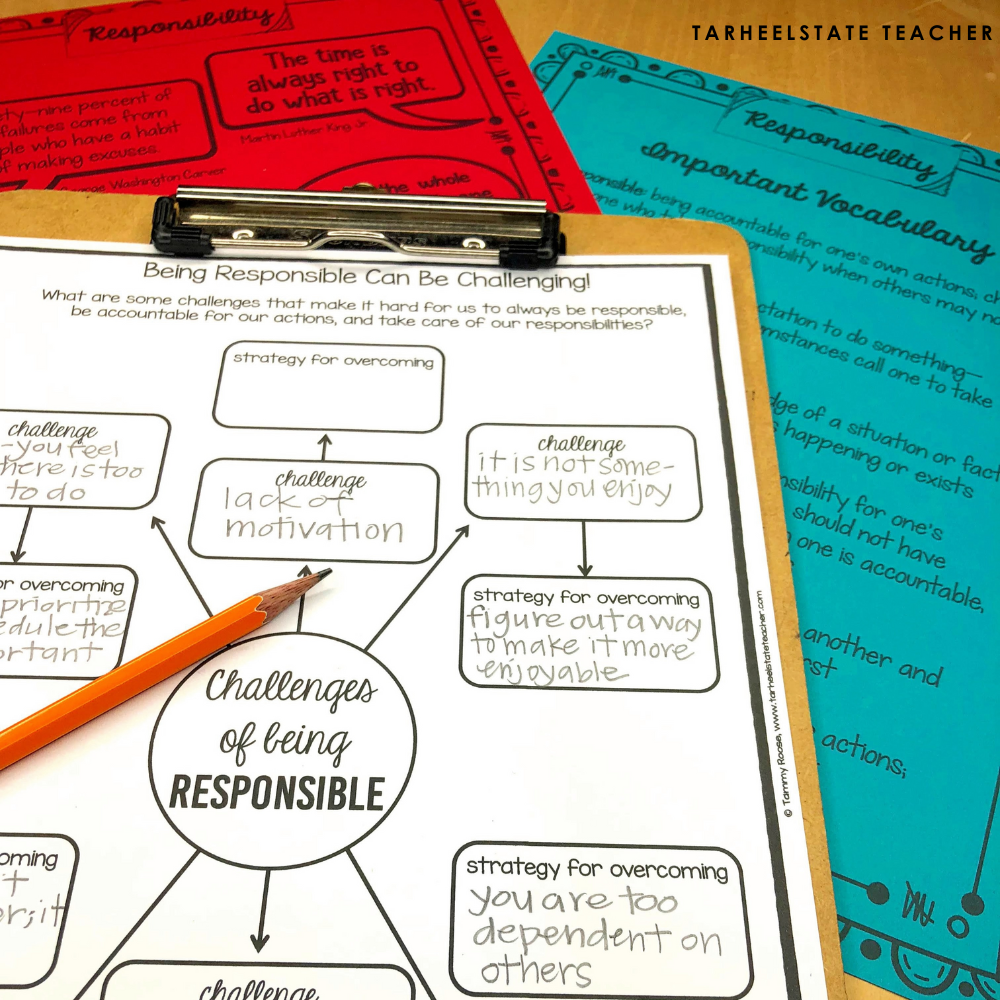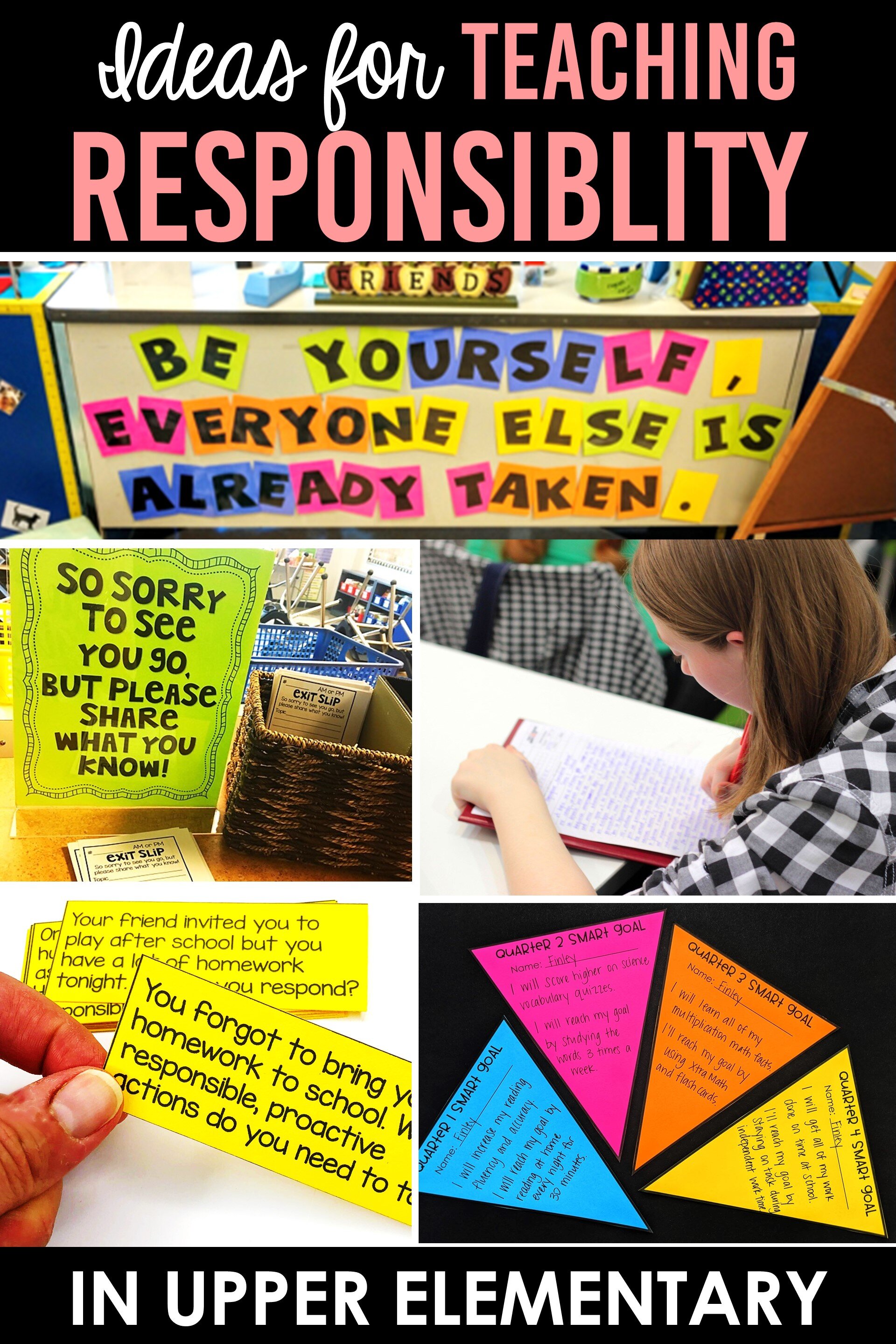Teaching Students to be Responsible and Accountable
We know that teaching students to be responsible is important for their academic success, for building strong character, and for helping them be successful in life. We all appreciate people who are responsible and we teachers LOVE those students who have a natural inclination for being responsible with their actions. But, how do we help students learn to become MORE responsible? I introduce “habits of highly accountable students” with my responsibility unit during morning meeting lessons. I incorporate a number of activities to teach and discuss responsibility with my upper elementary students. Let me share with you!
FIRST, DEFINING RESPONSIBILITY AND ACCOUNTABILITY
We must give students the language to properly discuss these ideas. I define responsibility as “being accountable for one's own actions; choosing to be one who takes responsibility when others may not think it is important.”
Accountability is a willingness to take responsibility for one’s actions—including the things we should do, should not have done, and when mistakes are made. An accountable person does not make excuses or place blame on others.
I post all of our key vocabulary about responsibility on our morning meeting bulletin board near our meeting carpet. This makes the terms and definitions really accessible to students and helps them internalize the concepts. Students also receive a copy of the vocabulary to put in their morning meeting journals.
🌟 You can find all of the resources for the responsibility unit in my website store or on Teachers Pay Teachers. Each Social Emotional Learning/Morning Meeting unit contains 15 days of editable lesson plans, a bulletin board, discussion questions, self-reflections and goal setting forms, student journal pages to accompany classroom discussions, activities, and reflections, suggested read alouds, videos, digital Google Slides for the teacher and student, and more!
7 HABITS OF HIGHLY ACCOUNTABLE STUDENTS (A LIST OF RESPONSIBILITY HABITS TO TEACH!)
In my research for what it truly means to be responsible and in thinking about how I can impart those characteristics to students, I came up with a list of 7 habits of highly accountable students.
Responsible, accountable students are willing to take responsibility and make sure what they have agreed to do gets done.
Responsible, accountable students don’t make excuses for themselves or place the blame for their lack of responsibility, completion, or accomplishment on others.
Responsible, accountable students do everything in their power to make sure commitments are completed on time. They know that planning is an important part of being responsible and accountable.
Responsible, accountable students are proactive and try to predict what needs to be done, areas where they can be more helpful, or move ahead without being told to do so.
Responsible, accountable students collaborate with others, ask for help when needed, and use all of the resources available to them in order to take responsibility for themselves and their learning.
When things go wrong or they get off track, responsible, accountable students take responsibility to think of other options and solutions.
Responsible, accountable students appreciate but do not expect a pat on the back for the responsibility they have taken. They are satisfied because they have kept their word and done their best!
In our responsibility morning meeting unit, students take each of these 7 responsibility habits and think about what the habit looks like in the classroom when it is being followed and when it is not being followed. Students consider how they can be more responsible in different school settings and in different aspects of their personal/home life.
OTHER STRATEGIES FOR TEACHING AND DISCUSSING RESPONSIBILITY
1) Read Alouds: We read picture books like But It’s Not My Fault by Julia Cook and What If Everybody Did That? by Ellen Javernick to develop a better understanding of what it means to be responsible. Picture books provide concrete examples of the effects of irresponsible actions and make for great discussions. I’ve compiled all of the responsibility-themed books I use during this unit into an Amazon list so that you can easily browse these books. (Note: As a participant in the Amazon Services LLC Associates Program, I may earn advertising fees at no cost to you by linking to amazon.com. Read my full disclosure here. )
2) Discussions and Scenarios: During our responsibility-focused unit, I even acknowledge that being responsible can be a real challenge. We work through different challenges we may face when trying to be responsible, then we brainstorm strategies for overcoming those challenges.
Using some situation slips I keep in a jar by our meeting space, we use any extra time to go through different “responsibility” scenarios and answer questions like, “How do you respond responsibly in this situation?” and “What proactive actions do you need to take?” These scenarios are relevant to students’ school, home, and community home settings.
3) Using Quotations: “The time is always right to do what is right!” and “99% of all failures come from people who make a habit of making excuses!” Responsibility quotes like these encourage and inspire my students to do their best, make strides to become more responsible, and care about the impact of their actions. I hang quotations like these on our morning meeting bulletin board and students get a copy of the quotations for their morning meeting journals.
NEED MORE RESOURCES AND DONE-FOR YOU ACTIVITIES FOR TEACHING RESPONSIBILITY?
You can manage to do each of these activities with a reflection journal and materials you have around the classroom, but if you want some of the work done for you, including digital resources like Google Slides, you can check out my Responsibility theme unit.
I use this unit for a 2-3 week morning meeting unit. It includes student journal pages, detailed and editable lesson plans, bulletin board materials with gratitude vocabulary and related quotations, and Google Slides for the teacher and a digital student notebook.
The responsibility theme unit is also included in Set 3 of the Social Emotional Learning Activities for Morning Meeting, along with courage, intrinsic motivation, friendship, and managing emotions.
Additionally, you can find it in the Morning Meeting MEGA Bundle that contains 16 social emotional themes. If you’re looking to increase your social emotional learning focus, you’ve come to the right place!
SOCIAL-EMOTIONAL TOPICS TO GUIDE YOUR MORNING MEETINGS ALL YEAR
If you’re looking to increase your social-emotional learning focus, you’ve come to the right place my friend! This Responsibility themed SEL unit is also included in the SEL Morning Meeting MEGA Bundle that contains 16 social- emotional learning themes. With units focused on gratitude, empathy and compassion, growth mindset, conflict resolution and compromise, grit and perseverance, responsibility, understanding and managing emotions, and so much more, your engaging SEL or morning meeting plans are done for you and your students will love them!
If you purchase the bundle from my personal website store, you can save 20% on the SEL Mega Bundle of all 16 topics with the code SEL20.
What tips and strategies do you use in the classroom to teach students about responsibility? Share with us in the comments below! 👇
LOOKING FOR MORE IDEAS TO INCREASE OPPORTUNITIES FOR STUDENTS TO LEARN ABOUT BEING RESPONSIBLE AND ACCOUNTABLE?
As teachers, we know there’s no silver bullet to make students more responsible over night, but if we don’t work with them where they are and support them in becoming more responsible, we can find ourselves very frustrated. Below, I’ve linked to some of the best strategies from my upper elementary teaching friends. In these posts, they share ways they’ve helped their students become more responsible for themselves and accountable for their learning! Check these out and grab the freebies along the way!
Using Quotes to Empower Students in the Classroom // Samson’s Shoppe
4 Quick Tips for Using Exit Slips in the Classroom // Think Grow Giggle
Empowering Students to Revise Essays (with Persuasive Rubrics Freebies) // Feel-Good Teaching
How to Increase Accountability with Student Led Conferences // The Learning Effect









